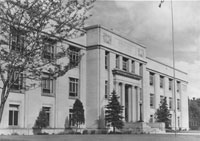Summary 2011 WY 21
Order issued by the Court on February 9, 2011
[SPECIAL NOTE: This order uses the "Universal Citation." It was given an "official" citation when it is issued. You should use this citation whenever you cite the order, with a P.3d parallel citation. If you need assistance in putting together a citation from this, or any future order using the Universal Citation form, please contact the Wyoming State Law Library and we will provide any needed assistance]
Summaries are prepared by Law Librarians and are not official statements of the Wyoming Supreme Court
Case Name: Freeman v. State
Citation: 2011 WY 21
Docket Number: S-11-0033
URL: http://wyomcases.courts.state.wy.us/applications/oscn/DeliverDocument.asp?CiteID=461741
Date of Order: February 9, 2011
ORDER DISMISSING APPEAL
This matter came before the Court upon its own motion following a review of recently docketed appeals. In his notice of appeal, Appellant indicates he is appealing from two district court orders: (1) an “Order Granting, In Part, and Denying, In Part, Motion to Correct Illegal Sentence,” which was entered on November 18, 2010, and (2) an “Order Denying Motion for Reconsideration,” which was entered on December 16, 2010. Appellant filed his notice of appeal on January 14, 2011.
With respect to the “Order Granting, In Part, and Denying, In Part, Motion to Correct Illegal Sentence,” the notice of appeal is clearly untimely as to that order. W.R.A.P. 2.01(a). An appeal from a trial court to an appellate court shall be taken by filing the notice of appeal with the clerk of the trial court within 30 days from entry of the appealable order.
The question becomes whether Appellant’s Motion for Reconsideration tolled the time for filing the notice of appeal. In a criminal case, pursuant to W.R.A.P. 2.03 there are certain post-judgment motions that toll the time for filing a notice of appeal. However, a Motion for Reconsideration is clearly not listed as the sort of motion that tolls the time for filing a notice of appeal in a criminal case.
The notice of appeal for the “Order Denying Motion for Reconsideration,” is timely as to that order. However, there is still the question of whether the motion could serve as an independent action. The Motion for Reconsideration did not create an independent action. The Court will not look at the substance of the motion for reconsideration but will declare it a nullity based upon its denomination. The obvious consequence of categorizing the motion for reconsideration as a nullity is that all judgments or final orders from said motion are a nullity. Thus, the Court lacks jurisdiction to consider an appeal from the ‘Order Granting, In Part, and Denying, In Part, Motion to Correct Illegal Sentence. Therefore, there being no final appealable order to review, the appeal must be dismissed.


